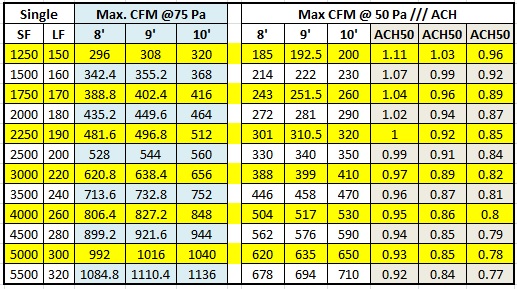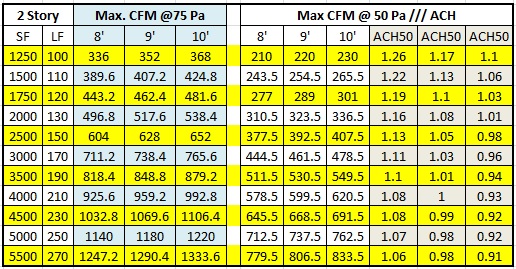 For those that may not know, jumping the shark is a term to describe a pivotal moment when a television show begins to decline in quality. This term was originally coined when the Fonz jumped a shark in a Happy Days episode.
For those that may not know, jumping the shark is a term to describe a pivotal moment when a television show begins to decline in quality. This term was originally coined when the Fonz jumped a shark in a Happy Days episode.
While the US version of Passive House is not a TV show (hereby to be called PHIUS), it sure has had it’s share of drama with it’s break from the original “Passiv Haus” to fights over should foam be allowed to be used, if at all. The latest is a complete rewriting of the standard which does away with the traditional .6 ACH, set limits on heating & cooling, etc… With that, let’s take a quick look at some the big changes & see what you think…
The new heating & cooling factors:
“15 kWH is dead” is a mantra of PHIUS & it clearly shows. Quite simply one had to ensure that a house didn’t use more than 15 kWh per SF (Passiv Haus had it broken down for heating & cooling per meter – PHIUS tried combining at first) to heat and cool which led to some interesting designs including a few builders using 17″ of sub slab insulation. While PHIUS was originally looking for a simple number that could apply to a large geographic area they arrived at this map below with now over 1000 different standards.
| Each point on the map lists the following criteria: |
|---|
City
iCFA= Interior Conditioned Floor Area – please note that last I checked they do not count interior walls or exterior walls (Regular SF calculation) like many other programs do. This also used to apply to the .6 ACH but as they have changed that up… |
0.6 ACH is dead:
The hall mark trademark of Passiv Haus was that they were built really tight – while modern codes allows for 3 ACH or less in most parts of the US, Passiv Haus only allowed for .6 ACH which, while tough was doable. The new standard requires 2 air-tightness tests to be run and instead of being based on Air Changes it is based on allowable leakage through the envelope. At 50 Pascals .05 CFM & at 75 Pascals (based on military testing) 0.08 CFM are the max. This equates to .77 to just over 1 ACH depending on the design of ones house.
The stated purpose for doing this was to help eliminate the small house penalty and due to the simple fact that air leakage happens through the envelope, not in the middle of a room. With that they have virtually ensured that almost all PHIUS buildings will have stairs in them as it is easier to hit the more relaxed standards with two or three story houses. For example these are the numbers for a simple single story house (max CFM allowed & what the ACH would be) followed up by two stories. For More: PHIUS – ACH Conversion.pdf

The Two Story numbers:

Per Person vs. Square Footage:
One of the other tweaks I see was under “The source energy limit was reconsidered on the basis of the global CO2 emission budget… Change to a per-person limit rather than per square foot of floor area, at least for residential projects. This follows the fair share principle and removes the penalty for those who seek to reduce their carbon footprint by building small homes.”
Interestingly I have seen quite a few people talk about actual number of occupants instead of the standard # of bedrooms +1 equaling the number of occupants. Not only does this contradict many established baselines (and where they will get certain numbers like “internal heat gains) it does bring up one issue – is a PHIUS home only a PHIUS home if X number of people or more live there?
For example a couple builds there 4 bedroom dream home that they want to raise three kids in – are they penalized because they haven’t had them yet? What happens if all the kids are in there teens, does the house no longer qualify when one, two or all three move out?
Jumping the shark or…
I hate to ruin it for most, but while they have loosened the standard pretty widely, I don’t think this would be considered jumping the shark. Granted I know a few builders that might feel a little cheated, but overall I think PHIUS will get what they are after, a slight to moderate uptick in certifications (and building better is never a bad thing).
They may even pick up some ENERGY STAR & Net Zero Energy Ready builders who were pretty close to it before but weren’t ready for the jump. Shoot if I am reading this properly this will even increase the ES & NZER builders as being certified by PHIUS means you also pick up those two certifications also.
As for builders, you may want to pay attention as you may just be looking at the 2030 (or earlier) code right here. In fact I have a feeling in the next one or two code cycles you will see a move from whole house ACH leakage numbers to a tighter envelope based one.
As for the critics from before whom they were trying to appease, all I can say is it was a good thing they weren’t on the moon project or we would still be looking at it with only a telescope. If it wasn’t for programs like this, Building America Challenge and others, do you really think that we would have moved so far forward in our quest for energy efficiency as we have? (now onto water)
My only big catch with this, is it makes a great standard – it just isn’t the Passive House standard and I think it should be rebranded. This is one reason why I will stick with calling it PHIUS. With that I would love to hear your thoughts…

Yay, we agree! I was worried with the whole jumping the shark thing.
Passive House needed a little flexibility, particularly with the wide range of climates in the US where Germany is homogenous in comparison.
I too can see similar standards becoming code. With what it looks like has been built, this isn’t insane to meet anymore. We live in the same climate zone now, and building Passive in CZ5 was wicked tough, only millionaires did it. I think there are less than 5 in Cleveland, I’m only sure of 2. This will greatly expand the reach of the standard, without substantially watering it down.
I like it!
LOL, glad I made your day & many thanks for chiming in. Bummed I will miss seeing you & everyone else at ACI this year. The only item got to disagree with some is that Passiv Haus has been successfully built in more wide ranging conditions then those found in just Germany. I would also dare say that while many things like this maybe considered for only the rich up front, new means & methods have come about bringing it down into the general masses reach. Have a great time & thanks again
Thanks for this lucid post. There has been an ongoing effort to encourage PHIUS to rebrand their offering. Instead, they have elected to spend the last three years bashing the Passive House standard, while fighting to retain the right to call themselves passive house. Silly. It’s been an incredibly negative and destructive choice.
The world certainly has room for more standards, and particularly one’s that work. It will be great if PHIUS focusses on producing real data on their new standard, showing that it actually does work and really is cost-effective.
In the meanwhile, there is a growing body of data indicating that the Passive House standard is working very well in various climates across the North American continent. Experience practitioners are reducing costs significantly as they gain experience and more affordable high performance components become available on our market. (Cell phones weren’t cheap when they first came out either!)
UofOregon study on 6 projects across the US: https://ases.conference-services.net/resources/252/2859/pdf/SOLAR2012_0256_full%20paper.pdf
California Marine Climate: http://www.nrel.gov/docs/fy15osti/63085.pdf
Washington State: http://www.nrel.gov/docs/fy15osti/63085.pdf
My pleasure and thanks for the kind words – sorry your comment got stuck in the cue & took so long for me to catch it.
Amen on the bashing as it sure hasn’t helped, but fortunately that hasn’t stopped many from building to the standard & proving it’s worth.
As for reducing costs, yep I recall when getting a house down to a HERS 50 was costly & a challenge, now thanks to DOE & their Challenge America Program (and numerous other ones) that share best practices – hitting a HERS of 45 rarely costs much more than a typical code built house